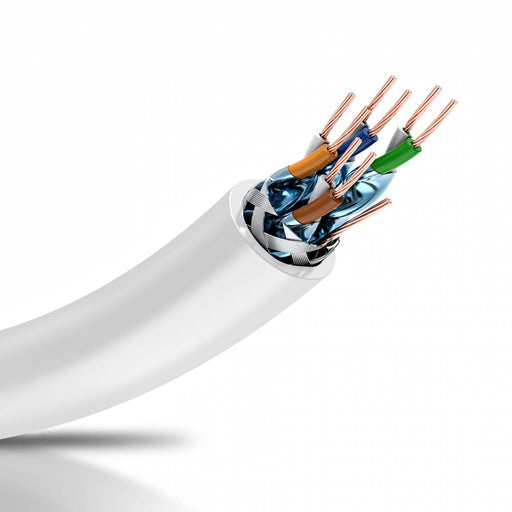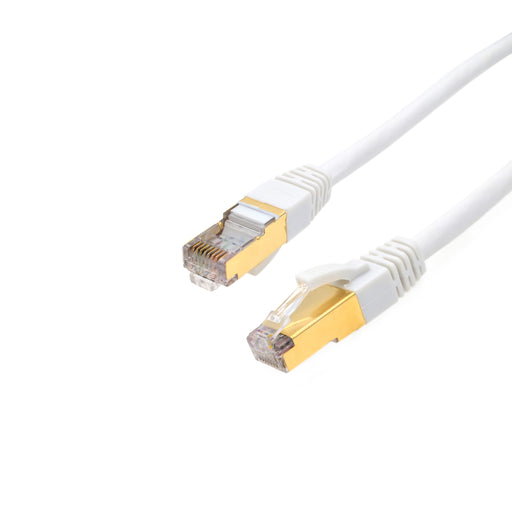Importance of Shielding in Patch Cable
Shielding in patch cables is extremely critical for maintaining signal integrity and minimizing electromagnetic interference. Here are some key reasons why shielding is important in patch cables:
- EMI Protection: Shielding significantly blocks unwanted EMI that can degrade signals and cause noise during audio or data transmissions across short and long distances.
- Longevity: Shielding protects the internal wires of the cable from external interference, enhancing the lifespan of the cable, and thereby guaranteeing reliable performance over time.
- Compliance: The use of CAT7 ethernet cable shielded helps industries to comply with standards such as IEEE, TIA/EIA, and FCC.
- Signal Loss Protection: By reducing EMI, shielding helps to maintain signal quality and prevent signal degradation over long cable runs. This, in turn, leads to faster data transmission speeds and more reliable network connections.
Advantages of CAT 7 Shielded Patch Cable
CAT7 shielded patch cables offer a range of advantages that make them a preferred choice for high-speed networking applications. A few of the notable advantages of using shielded CAT7 patch cable include:
- Enhanced Speed and Bandwidth: CAT7 cables support high data transfer speeds and bandwidth compared to lower category cables, making them ideal for bandwidth-intensive applications like online gaming and streaming media.
- Future-Proofing: Designed to meet the latest industry standards and backward compatible with previous categories, investing in CAT7 cables allows you to future-proof your network infrastructure for emerging technologies and higher data speeds.
- Security: The shielding on CAT7 cables provides an added layer of security, protecting against interference and ensuring a secure network connection, which is crucial for handling sensitive data.
- Improved Signal Quality: CAT7 cables minimize electromagnetic interference, ensuring strong and reliable data signals for improved network performance.
- Durability: With robust construction using high-quality materials, CAT7 shielded cables are made to last, reducing maintenance costs and ensuring a reliable network connection over the long term.
- Enhanced Protection Against Crosstalk: Each wire pair in CAT7 cables has unique shielding to reduce electromagnetic interference between cables, minimizing transmission quality issues and preventing signal distortion even in high-interference regions.
Applications
There is a wide range of networking application area where our 50ft cat7 ethernet cable and100ft cat7 ethernet cable, among other models find widespread use. A few of their application areas include:
- Industrial Automation
- Audio-Visual Installations
- Healthcare Facilities
- Financial Institutions
- Data Centers
- Telecommunication Networks
How to Choose the Right Cat7 Shielded Cable for Your Application
Choosing the right CAT7 shielded ethernet cable involves several considerations. The following tips will ease your selection process.
- Address Your Network Needs: Consider both present and future network needs. CAT7 shielded cable is ideal for high data transmission demands and network upgrades.
- Analyze Length Requirements: CAT7 Ethernet cables come in various lengths, including 1', 5', 10', 25', 50', 75', and 100'. Plan your network layout carefully to avoid signal loss over long distances.
- Address the Physical Conditions of the Installation Area: CAT7 Ethernet cables are thicker and less flexible than lower-category cables. Plan your network layout accordingly, especially if you have space constraints.
- Check Compatibility: Ensure CAT7 Ethernet cables are compatible with connectors and hardware used in your application. CAT7 cables typically use TERA or GG45 connectors, which are backward compatible with RJ45 connectors.
- Focus on Quality: Look for cables that meet CE, ETL, and ROHS certifications to ensure they meet safety and quality standards.




